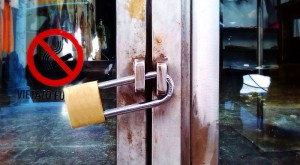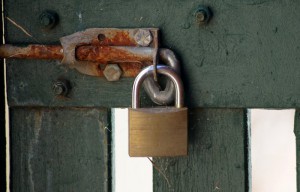Today we’ll begin a series of bogs that will accompany us, from time to time, over the coming months.
It is practical advice, summarised in the form of “bites“, suitable for users of security products, to be aware of the most effective ways for applying and using these products.
In fact, quite often very little is needed to avoid the risks, even potentially serious ones, related to an unintentionally incorrect installation and/or use.
Let’s start by talking about padlocks.
“Good morning, I need a good quality padlock, please!”
The wide range of choice in the field of the padlocks can be confusing, even due to the fact that when we go to a hardware store we find padlocks of all shapes and sizes, cylindrical and rectangular, long shackle, brass or steel etc.
The very fact that there are many different products means it is possible to satisfy many specific requirements. However, choosing the wrong padlock, as well as a simple mistake committed due to carelessness or lack of experience, can compromise the operation of the padlock. Let’s look together at three types of behaviour to be avoided, to ensure the maximum security of our padlock.
- Even the best padlock loses its effectiveness if it is anchored to fixing points which are weaker than the padlock itself. In this case, any thief will attack the fixing point, making the presence of the padlock simply useless.
- A good fixing point should not only withstand possible attacks, but it must also couple in the best possible way with the padlock to minimise the space available for the thieves when attempting to force the padlock itself with burglary or cutting tools. The shackle is the most critical point in a padlock from the security point of view. For this reason one should use padlocks with a long shackle only when really necessary.
- The first enemy of a padlock are potential attackers, but, especially if used outdoors, rain, salinity and dust are not to be underestimated, since in the long run they can corrode, rust and block the padlock, such as to render it useless. These harsh climatic conditions are to be found especially close to the sea, but acid rain in towns or temperature fluctuations in the mountains can also put a strain on padlocks.
The general rule for all security systems also apples to padlocks: the overall resistance is given by the resistance of the weakest link in the “chain”, not by the strongest.
A simple way to increase the security of a padlock is therefore to increase the strength of its fixing points. For this reason, the major producers of padlocks also provide a wide range of fixing accessories, suitable for every type of need.

The photo shows a classic example of a padlock with a long shackle used inappropriately. In this situation, due to the excessive free space between the padlock shackle and body, it would be particularly easy for a potential thief to attack the shackle with a cutter or, even more simply, with a simple crowbar.
Long shackle padlocks, with the same dimensions of the body, are less secure than the corresponding standard shackle padlocks, because they leave the body even more uncovered, and because the shackle length amplifies the effectiveness of any lever used to break it. They should therefore be used only when the two fixing points are far apart and do not allow the use of other types of padlock.

In this case, to cope with these problems padlocks are included in catalogues which are usually referred to as “marine “, because they have features which make them more resistant to moisture and salinity in the air, which is particularly high near to the sea.
Conclusions
Finally, remember that, at the time of purchase, it is often advisable to resort to the help of a good dealer who will undoubtedly be able to suggest the best type.
Also read: how to recognise a reliable padlock at first glance and avoid making wrong purchases

